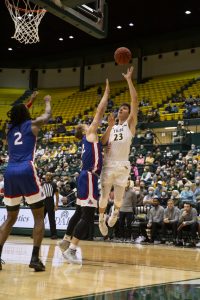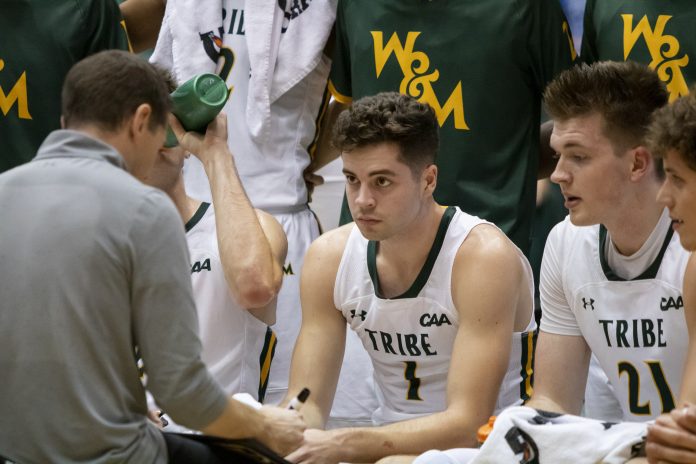The Tribe has opened their season with a dismal 1-8 record. Their average loss score is 69.4 to their opponents’ 87.6. They are shooting 34% on the season. From the free-throw line, they average 66.8%. Broken down by half, they free throw 56.2% and 69.8% respectively.
Those stats are pretty hard to look at. To some, this season of Tribe basketball is simply a rebuilding year. Those statistics surely exemplify that train of thought: we have a young team, with relatively inexperienced players. However, even rebuilding years must build skills for the team to use in future seasons, and right now, that growth is not visible on the court.
This is not the first time the Tribe has opened with a sub-.250 record in recent history. In 2018-2019, the Tribe began 2-9. Over the course of the season, they finished 14-17 (10-8, CAA). It wasn’t a winning record, but their late-season performance was enough to get to the Colonial Athletic Association Championship tournament, where they lost in the quarterfinals.
To see how the Tribe can regain the reins of the 2021-2022 season, we must look back to the 2018-2019 season. The 2018-2019 season suggests interesting strategies to implement to improve current Tribe play.
This current spell of losses is not a product of playing extraordinary opponents. These losses are not the product of the Tribe having one of the youngest teams in the nation. The Tribe must look for sustained effort and whole team play in matches, according to 2018-2019.
First, the Tribe needs focus in big moments. So many games this season have been decided by a pivotal lead change. The Tribe has missed the go-ahead free throw, leading to a possession change and opponent scoring tear (American). Or, the Tribe’s lead has been chopped by the opponent, and they lose momentum (Howard). When it matters, the Tribe is indecisive. They take the first shot, instead of waiting for a more quality basket.
Compare that to 2018-2019. In the turning point of the season on Dec. 8, 2018, the Tribe found itself trailing by one to Hampton with a little more than three minutes remaining. A few baskets later, and the teams were tied at 69 with a minute and a half left. Then-junior forward Nathan Knight dunked a basket on a breakaway, was fouled and converted on the ensuing free throw to put the Tribe up 3. More than just assuming the lead briefly, the Tribe was able to capitalize on Knight’s contributions to top the Pirates, 76-71.
How does one coach a team in stressful moments? How does one simulate high stakes in practice? Head coach Dane Fischer has his work cut out for him. This sort of momentum mindset coaching must happen. Drilling routine shots is fine, but wins will come from practicing in-game scenarios.

Second, the Tribe must rely on a full team effort. Lots of buzz was made about sophomore guard Connor Kochera after his breakout freshman year, netting several CAA awards. Fischer and fans alike looked to Kochera to lead the team in point production for the 2021-2022 year.
Currently, Kochera is averaging just over ten points per game. Last season, he averaged over 13.
But Kochera is not to blame for the Tribe’s success — or lack thereof — this season. Kochera is a talented, two-way player, but he is not the next Knight. He doesn’t need to be. But, because the 2021-2022 Tribe does not have a point sponge, the rest of the team must contribute.
Looking to 2018-2019, stories came out in the summer about then-redshirt junior guard Matt Milon. The previous season, he averaged 13 points per game, at a shooting percent of 45. Those numbers eerily mirror Kochera’s.
At the beginning of the season, Milon faltered in his point production. After the first few games, his team caught him and stepped up. Knight and freshman Chase Audige made headlines for points. Milon did not exceed expectations at first — after a period of readjustment, the Tribe began to win.
Milon finished the season matching his stats from the last. The full team effort helped bolster his own production as well. Without the responsibility laying on his shoulders, he could produce better quality shots and help the team where it mattered.
Kochera, along with the 2021-2022 team, has had a less than expected performance to open the season. If 2018-2019 tells us anything, it says this can be mitigated through the rest of the Tribe stepping up to help. Kochera has created opportunities for others to shoot, and despite their short collegiate careers, the Tribe must step up to the plate as well.
The Tribe plays next on Tuesday, Dec. 7, at home against Old Dominion. If their current record tells us anything, it is time for the Tribe to adopt a new strategy. That strategy should come from the success of the 2018-2019 season: capitalizing on high-stakes moments combined with a full team effort.

